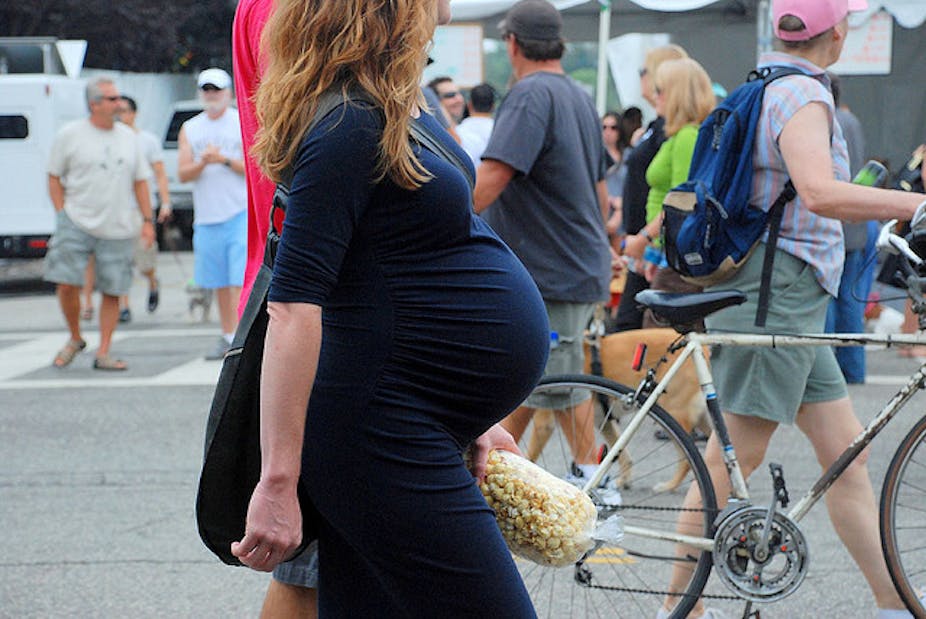Advances in medical science and technology have significantly reduced the risk of serious complications and death during pregnancy and birth. You’d think this would make mums-to-be more relaxed than they used to be. But perceptions of risk during pregnancy have increased; so have rates of stress.
And it’s no wonder. Women are constantly warned about things that can go wrong during pregnancy: don’t be too old, don’t be too fat, don’t eat soft cheese, don’t eat pâté, don’t drink alcohol, don’t ride roller-coasters, don’t live near the freeway – and on the list goes.
So how, and when, did risk and fear become so entrenched in the minds of pregnant women?
Risky business
The worry is partly an artifact of history: maternal death in childbirth was very high until the 1930s, when penicillin and safe cesarean sections were introduced. Then there was thalidomide in the late 1950s and early 1960s. Prescribed for morning sickness, the drug was withdrawn in 1962 after it was discovered to cause severe birth defects.
Although some time ago, the thalidomide tragedy has left its imprint on pregnancy with the implication that things we take during pregnancy might harm the baby. This is perhaps best illustrated by a study where women were asked to estimate the risks of birth defects after exposure to a number of medications during pregnancy, including analgesics and antihistamines.
The participants predicted a one-in-four chance that these medications would cause birth defects – the same as with thalidomide – even though the substances were classified as safe during pregnancy.
Fetal surveillance
Combine this history with the current context. Substantial advances in prenatal testing and screening, particularly in ultrasound technology, have led to far greater “surveillance” of the developing fetus and the ability to diagnose potential problems early.
But with that added surveillance comes more focus on risk for pregnant women. What if the test or scan shows something is wrong?
If an early scan (usually at 12 weeks) does indicate a higher risk for genetic disorders, Down syndrome or neural tube defects (such as spina bifida), there’s often a stressful and emotional wait for further testing. For Down syndrome, an amniocentesis is generally performed after 15 weeks. There’s also an elevated risk of miscarriage associated with some further testing procedures.
Difficulty conceiving
One in 25 babies are now born via fertility treatment such as in vitro fertilisation (IVF). This can be an incredibly stressful process – physically, emotionally and financially – for women and their partners. Perhaps unsurprisingly, a recent study found women undergoing fertility treatment had significantly higher anxiety levels than women trying to conceive naturally.
And when it’s so difficult to get pregnant, the mother has extra motivation to guard against harms to the baby. A recent Australian review showed that women who conceive via fertility treatment can find the transition to parenting difficult and may initially have lower confidence in their mothering ability.

Information overload
An increasingly important influence on the over-estimation of risk in the modern pregnancy is the use of social networking to share and find information.
Despite its perceived lowly status among clinicians, anecdotal data have a disproportionately powerful influence on patients – stories of things going wrong in pregnancy and birth are likely to resonate with patients much more than statistics. And now these anecdotes are easily passed beyond the immediate family and friends of a pregnant woman and cited as “evidence”.
Scientists can dismiss anecdotes, but people don’t always know what constitutes good science. The vaccination/autism debate is a pertinent (and frightening) example. A friend of a friend with a baby who reacted poorly to a vaccination might have significant influence on a mother’s decision to vaccinate her child, despite a single case among thousands of babies having little meaning scientifically.
As researchers and clinicians, we need to do more to replace this misinformation about pregnancy and parenthood, however well-intentioned, with evidence-based advice. And social media is a good place to start.
The impact of stress
If all of these elements lead to an over-estimation of risk in the modern pregnancy, should we be concerned? After all, isn’t it important to be vigilant?

The reality is that stress and anxiety during pregnancy can raise the risk for preterm birth and low birth weight. It can even affect the development of the child’s own stress response system, which may manifest as emotional and behavioural problems later in their life.
The stress that has been linked to these outcomes doesn’t have to be major stress: even everyday events such as moving house, money problems and relationship problems can have a negative impact.
We also know that women who express more worries about their baby’s health are more likely to experience depressive symptoms during pregnancy.
The end result is that the heightened focus on what can go wrong and efforts to ensure it doesn’t could potentially be doing more harm than the feared risk itself.
So if you’re pregnant or planning a pregnancy, be aware of stress and seek ways to manage it. This might include support from loved ones, light exercise, yoga and relaxation, or talking to your obstetrician or midwife about your concerns. Do your best to reduce your exposure to stressful environments.
For the rest of us, the focus on dos and don’ts must be tempered with support and understanding of what can be a stressful time.

